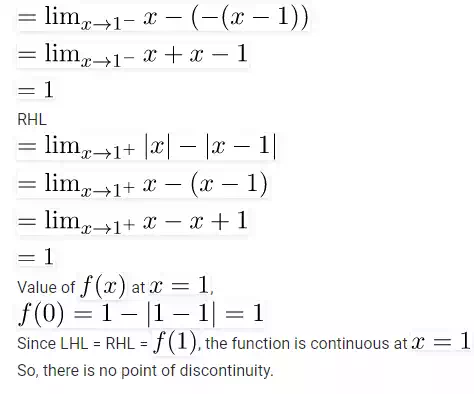Mathematics | Limits, Continuity and Differentiability
1. Limits
For a function  the limit of the function
at a point
the limit of the function
at a point  is the value the function achieves at a point which is very
close to
is the value the function achieves at a point which is very
close to  .
.
Formally,
Let  be a function defined over some interval containing
be a function defined over some interval containing  , except that
it
, except that
it
may not be defined at that point.
We say that,  if there is a number
if there is a number  for every number
for every number  such that
such that
 whenever
whenever 
The concept of limit is explained
graphically in the following image

As is clear from the above figure, the limit can be approached from either
sides of the number line i.e. the limit can be defined in terms of a number
less that  or in terms of a number greater than
or in terms of a number greater than  . Using this
criteria there are two types of limits
. Using this
criteria there are two types of limits
Left Hand Limit If the limit is defined in terms of a number
which is less than  then the limit is said to
be the left hand limit. It is denoted as
then the limit is said to
be the left hand limit. It is denoted as  which is
equivalent to
which is
equivalent to  where
where  and
and  .
.
Right Hand Limit If the limit is defined in terms of a number
which is greater than  then the limit is said to
be the right hand limit. It is denoted as
then the limit is said to
be the right hand limit. It is denoted as  which is
equivalent to
which is
equivalent to  where
where  and
and  .
.
Existence of Limit The limit of a function  at
at  exists
only when its left hand limit and right hand limit exist and are equal i.e.
exists
only when its left hand limit and right hand limit exist and are equal i.e.

Some Common Limits

LHospital Rule

Example 1 Evaluate 
·
Solution The limit is of the form  , Using
LHospital Rule and differentiating numerator and denominator
, Using
LHospital Rule and differentiating numerator and denominator




·
Example 2 Evaluate 
·
Solution On multiplying and dividing by  and re-writing
the limit we get
and re-writing
the limit we get


2. Continuity
·
Example 1 For what value
of  is the function defined by
is the function defined by

continuous at  ?
?
·
Solution For the
function to be continuous the left hand limit, right hand limit and the value
of the function at that point must be equal.
·





3. Differentiability


